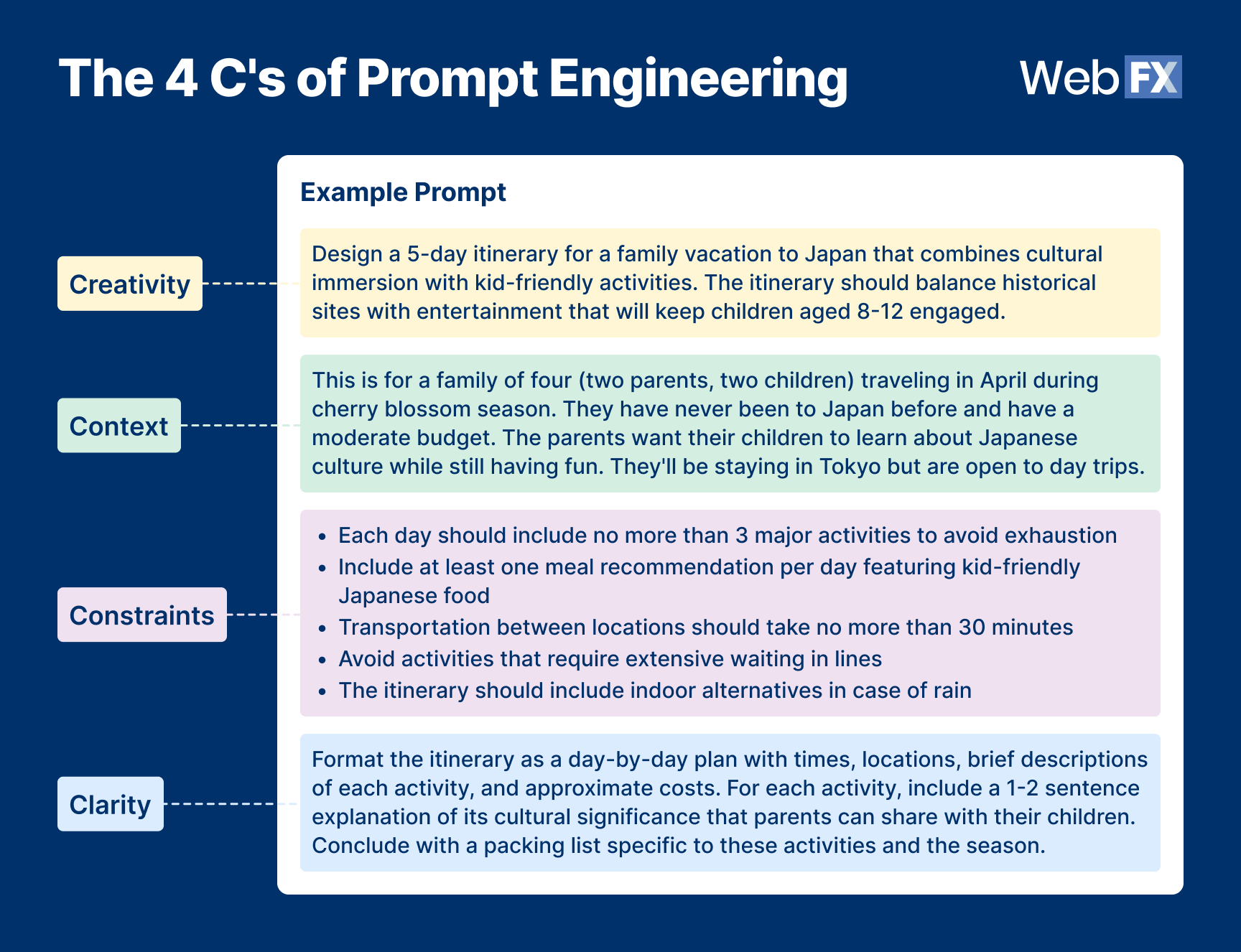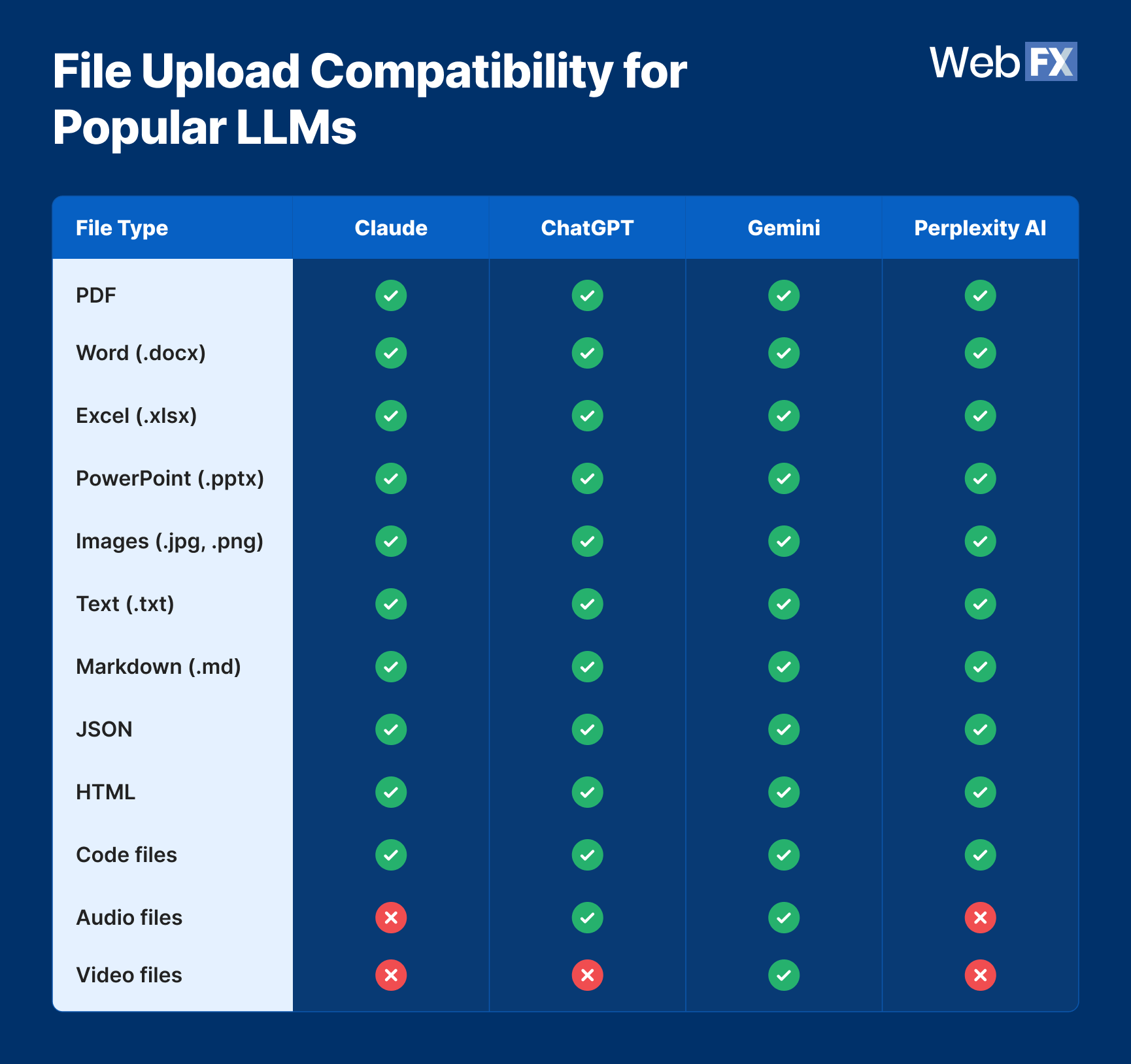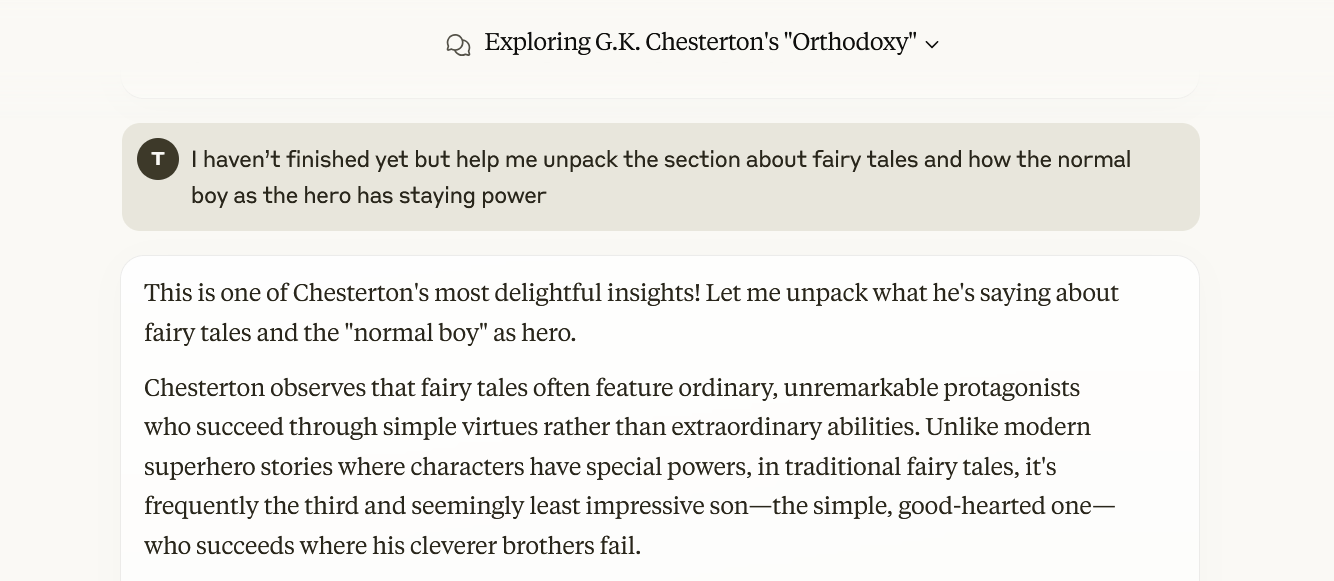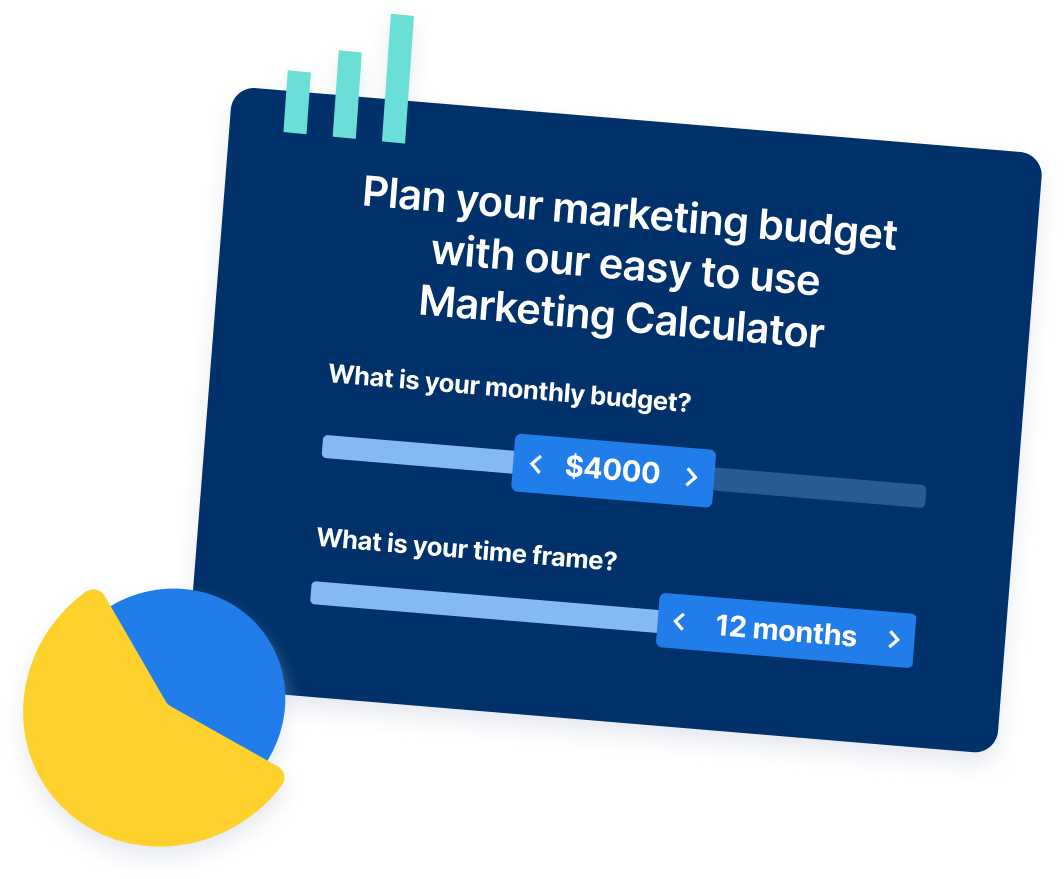-
 Published: Mar 20, 2025
Published: Mar 20, 2025
-
 9 min. read
9 min. read
-
 Trevin Shirey
Trevin Shirey VP of Marketing
VP of Marketing
- Trevin serves as the VP of Marketing at WebFX. He has worked on over 450 marketing campaigns and has been building websites for over 25 years. His work has been featured by Search Engine Land, USA Today, Fast Company and Inc. Read his review of working with WebFX for the last 15 years.
TLDR
Master the art of AI prompt engineering for better results with the 4C Framework:
- Creativity: Starting with a strong, well-defined idea. The stronger and more unique the idea, the better the output. This is the human magic needed to really utilize AI to its fullest potential.
- Context: Providing relevant background information — explain the why in as much detail as you can.
- Constraints: Setting clear boundaries and requirements. How should the LLM surface information?
- Clarity: Using precise unambiguous language and specific instructions about the format you want the response to be in and how it’s structured.
When ChatGPT first launched and went viral, some of the common sentiments around the tool were that it was a shortcut to doing real work. Anybody could type in a few sentences and get text back that they could use for anything under the sun. In fact, ChatGPT reached 100 million users just two months after launch — the fastest adoption rate of any consumer application in history — with users generating over 10 billion prompts per day by mid-2024.
As ChatGPT and other LLMs have evolved, they’ve certainly created shortcuts, but one thing we’ve all learned is that prompting is an art form in itself. The output you get isn’t perfect…sometimes it isn’t even usable. We’ve all experienced the frustration of typing something like “give me blog ideas” only to receive generic suggestions, while watching others get brilliant, tailored content with seemingly magical prompts.
We’ve all learned there are good ways and bad ways to chat with these tools. There are heavy users who get valuable output from LLMs with a snap of their fingers and others who seem to struggle to save any time. It’s clear that AI prompt engineering is a skill that needs to be developed.
Before we explore further, what do I mean by prompting?
What is AI prompting?
AI prompting is the art of crafting clear, specific instructions that effectively communicate with AI systems to produce desired outputs. It involves strategically combining creativity, context, constraints, and clarity to guide the AI toward generating the most useful, relevant, and high-quality responses.
Anecdotally, the folks I’ve spoken with who receive weak responses from LLMs tend to be delivering poor prompts. They’ll ask for a report on a particular company but only type “Give me a report about Boeing” into their chat interface. Much like many of us have grown up learning how to “speak” search engine, AI prompts require you to think about how you ask a certain question to generate the best response.
LLMs are much better at natural language, but you still need to be able to properly think through a few things when prompting to receive truly magical responses. Here’s what I’ve found to be the four keys to effective AI prompts.
The 4 C’s: AI prompting best practices
- Creativity: Starting with a strong, well-defined idea. The stronger and more unique the idea, the better the output. This is the human magic needed to really utilize AI to its fullest potential.
- Context: Providing relevant background information — explain the why in as much detail as you can.
- Constraints: Setting clear boundaries and requirements. How should the LLM surface information?
- Clarity: Using precise, unambiguous language and specific instructions about the format you want the response to be in and how it’s structured.
If you’re looking to convert from metric to imperial do you need to get this detailed? Of course not. But for more heavy-duty prompts, adding this level of detail is a big separator.
Here’s an example prompt with each of the 4 C’s highlighted:

The four C’s approach will get you much more helpful answers to your queries and tailor the approach to your precise needs.
Good vs. bad AI prompts: Traits and examples
Let’s take a deeper look at how not to prompt and some bad habits you should aim to break if you want to get the most out of LLMs.
| Trait | Bad Prompts | Good Prompts |
| Specificity | Vague and general | Precise and detailed |
| Structure | Disorganized, single sentence | Well-organized with clear sections |
| Context | Minimal or missing background | Rich, relevant background information |
| Instructions | Unclear or implied expectations | Explicit directions and requirements |
| Format guidance | None provided | Clear format preferences specified |
| Examples | No examples or references | Includes examples of desired output |
| Purpose | Unclear goals | Clear intended outcome |
| Constraints | No boundaries or limitations | Specific parameters and limitations |
Example transformation
Bad Prompt: “Tell me how to use Instagram Reels.”
Good Prompt Using the 4 C’s Framework:
Creativity: Create an actionable guide on using Instagram Reels to increase engagement for small e-commerce businesses selling handmade products. The guide should focus on organic growth strategies rather than paid advertising.
Context: This is for a community of artisans who have basic social media knowledge but limited time and marketing budgets. Most have fewer than 1,000 followers and sell products in the $30-100 range. They’re competing against mass-produced items and need to showcase their craftsmanship effectively.
Constraints:
- Keep strategies feasible for someone spending 3-5 hours per week on social media
- Focus only on Instagram Reels, not other platforms or features
- Avoid strategies requiring expensive equipment beyond a smartphone
- Include only tactics that have proven effective since Instagram’s 2023 algorithm updates
- Must be appropriate for businesses in various creative niches (jewelry, ceramics, textiles, etc.)
Clarity: Structure the guide with an introduction explaining why Reels are valuable for artisans, followed by 5-7 specific strategies with step-by-step instructions. For each strategy, include a specific example, estimated time investment, and expected outcomes. Conclude with a weekly content planning template and 3-5 content ideas tailored to handmade businesses. Use straightforward language, bullet points for actionable steps, and highlight any technical terms that beginners might not understand.
Don’t be afraid to ask AI for help with prompting
One of the most overlooked resources for improving your prompting skills is right in front of you: the AI itself. Think of it like asking a local for directions in a new city — they know the terrain better than any map.
When I first started using AI tools, I would spend hours crafting the “perfect” prompt, only to receive mediocre results. Then I had a revelation: why not just ask the AI how it prefers to be prompted? It’s like asking a chef how they’d like ingredients prepared before cooking them.
“How would you recommend I prompt you about website redesign strategies so you can provide me with a 3-page action plan?”
The AI will often provide format suggestions, key elements to include, and even example prompts that you can modify for your specific needs.
Daisy chain prompts across models
Different AI models have different strengths — think of them as specialists in a hospital. Google Gemini might excel at research-heavy tasks across a ton of websites, gathering comprehensive information on a topic. You can then take that research and feed it to ChatGPT or Claude to synthesize and structure it into actionable insights.
This approach is like a relay race, where each runner (AI) handles the leg they’re best at. I recently used this to analyze some data in a large CSV file. Claude handled the heavy analysis, and ChatGPT ran a Deep Research report to add some broader context to the findings. The result was a masterpiece of data analysis and the impact/context surrounding the analysis.
Upload your own data for precision
Generic prompts produce generic results (if you take one tip away from this article, let it be this one). Providing your own data is like giving the AI a custom map instead of general directions.
LLMs are able to process a big variety of file types nowadays, in addition to being able to read specific URLs in a lot of cases. A lot of times when we’re prompting, we’re referencing something specific, and simply adding that file or information works wonders.
File upload compatibility for popular LLMs

Treat AI conversations as ongoing dialogues
The most powerful prompting isn’t a one-shot effort — it’s an iterative process, like sculpting clay. Your first attempt might give you a rough shape, but each subsequent refinement brings you closer to your vision.
I’ve found this especially valuable when brainstorming creative projects. Rather than expecting perfection immediately, I view each AI response as a stepping stone. “That’s interesting, but can we explore the second point more deeply?” This conversational approach allows the AI to build on previous context rather than starting fresh each time.

One of my favorite applications is using Claude as a reading companion for non-fiction books. After finishing a chapter on behavioral economics, I’ll discuss key concepts with the AI as if we’re in a tiny book club. “What did you think about the author’s perspective on loss aversion? I found it interesting how it contradicted…” The AI helps highlight connections I might have missed and suggests related concepts to explore — all because we’re maintaining a continuous conversation rather than exchanging isolated prompts.
By approaching AI prompting as a collaborative, iterative process rather than a one-time command, you’ll unlock much richer possibilities from these increasingly sophisticated tools.
Prompt engineering is no longer just a technical skill — it’s becoming an essential literacy in our AI-powered world. By mastering the 4 C’s framework — Creativity, Context, Constraints, and Clarity — you can transform your AI interactions from frustrating exchanges into productive partnerships. The difference between someone who struggles with AI tools and someone who leverages them effectively often comes down to how thoughtfully they craft their prompts.
Remember that the best AI prompting isn’t about finding a perfect formula or magic words — it’s about clear communication, specific details, and an iterative approach. Start with strong ideas, provide rich context, set appropriate boundaries, and be precise in your instructions. As you practice these principles, you’ll develop an intuitive sense for what works, making each interaction more valuable than the last. The most powerful AI tool at your disposal isn’t the latest model or feature — it’s your ability to ask the right questions in the right way.
Harness the power of AI for your business
If you’re ready to take your AI capabilities to the next level, WebFX can help you unlock the full potential of these powerful tools. Whether you’re looking to streamline content creation, enhance data analysis, or develop customized AI-driven strategies, our team has the expertise to guide you through it all.
AI is only as powerful as the way you use it, and with the right approach, it can be a game-changer for your business. Don’t leave results to chance—partner with WebFX to get tailored AI solutions that drive real impact. Contact us today and let’s build an AI strategy that works for you!
-
 Trevin serves as the VP of Marketing at WebFX. He has worked on over 450 marketing campaigns and has been building websites for over 25 years. His work has been featured by Search Engine Land, USA Today, Fast Company and Inc. Read his review of working with WebFX for the last 15 years.
Trevin serves as the VP of Marketing at WebFX. He has worked on over 450 marketing campaigns and has been building websites for over 25 years. His work has been featured by Search Engine Land, USA Today, Fast Company and Inc. Read his review of working with WebFX for the last 15 years. -

WebFX is a full-service marketing agency with 1,100+ client reviews and a 4.9-star rating on Clutch! Find out how our expert team and revenue-accelerating tech can drive results for you! Learn more
Try our free Marketing Calculator
Craft a tailored online marketing strategy! Utilize our free Internet marketing calculator for a custom plan based on your location, reach, timeframe, and budget.
Plan Your Marketing Budget
Table of Contents
- The 4 C’s: AI Prompting Best Practices
- Good vs. Bad AI Prompts: Traits and Examples
- Example Transformation
- Don’t Be Afraid to Ask AI for Help with Prompting
- Daisy Chain Prompts Across Models
- Upload Your Own Data for Precision
- File Upload Compatibility for Popular LLMs
- Treat AI Conversations As Ongoing Dialogues
- Harness the Power of AI for Your Business

Proven Marketing Strategies

Proven Marketing Strategies
Try our free Marketing Calculator
Craft a tailored online marketing strategy! Utilize our free Internet marketing calculator for a custom plan based on your location, reach, timeframe, and budget.
Plan Your Marketing Budget





